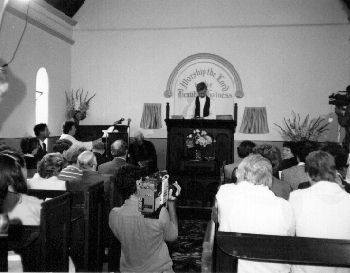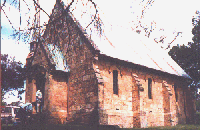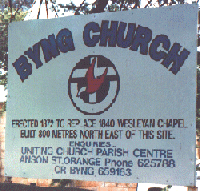Cornish Settlement (Byng)
Wesleyan Chapels - Built for Cornish Settlers
Bethel Rock
When William Tom Senior received his Land Grant west of the River Macquarie, it became known as Springfield and the centre of a remarkable collection of Cornish families, so much so that the location was dubbed the Cornish Settlement. Most of these families came from a background steeped in the principles which John Wesley had instilled in their parents and grandparents in the 18th Century. Waiting for an ordained minister to join the gathering and to expound on religious matters was not essential to their faith, as lay preaching was an accepted aspect. William Tom was one such lay preacher, well known by this time as 'Parson' Tom.
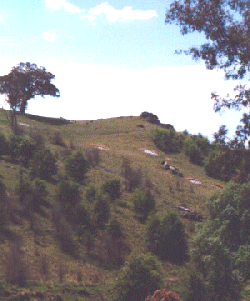
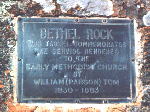 In the early days of the Settlement after 1829, these Cornish pioneers understood that walls alone do not make a meeting place, just as John Wesley had demonstrated in their home county. Their initial chosen place of worship was the top of a ridge, soon known as Bethel Rock, and this served as 'Parson' Tom's pulpit. In the photograph, Bethel Rock is the exposed rock close to the downslope to the right.
In the early days of the Settlement after 1829, these Cornish pioneers understood that walls alone do not make a meeting place, just as John Wesley had demonstrated in their home county. Their initial chosen place of worship was the top of a ridge, soon known as Bethel Rock, and this served as 'Parson' Tom's pulpit. In the photograph, Bethel Rock is the exposed rock close to the downslope to the right.
When his own dwelling was constructed, folk gathered there for their services regularly until a small Wesleyan Chapel was opened in 1842, in the valley below their original meeting place at Bethel Rock.
As part of the 1988 Bicentennial Celebrations, a plaque was placed on Bethel Rock to commemorate by William Tom in bringing religious services to the Cornish community and others who settled at the Cornish Settlement.
The First Chapel at Cornish Settlement
Only a pile of rubble marks the first chapel at Cornish Settlement, as it is understood that worthwhile stones were used later for the second Chapel which stands to this day. Neverthless, the site is not only marked by the rubble remains but also by a memorial stone which stands together with early tombstones to those who were buried there. The Monument at Byng has the following inscription:
The first church west of Bathurst was erected here
at Cornish Settlement May 1842
The Memorial dedicated by Rev. Dr. R.B. Lew
Unveiled by Mrs J. Kemp Glasson 24-9-1961
Here is a list of those interred in this beautiful valley:
WILLIAMS, Steven, died 11-9-1851, 83 years
HAWKE, William, son of Richard and Johanna Glasson, died 9-11-1847, 18 weeks
FREEMAN, James, son of James and Elizabeth, died 2-1-1847, 12 years
FREEMAN, Fanny Louisa, daughter of James and Elizabeth, died 25-9-1849, 1 year 8months
DAVIS, Louisa, died 9-11-1848?, 24 years
BOOTH, Charles, died 15-10-1851, 68 years
The Present Day Byng Chapel
The second Bible Christian Chapel was built in 1872 to plans set out by the architect Thomas Rowe who designed many other buildings in Sydney and its suburbs, notably Sydney Hospital, Newington College and Sydney Arcade. Thomas Rowe was born in Penzance, Cornwall, where he trained; he practised in Sydney from 1857 to 1895. Following its completion, the chapel was opened in 1873 at a time when the population still numbered hundreds. With the amalgamations of the religious groupings of Wesleyan origin, the chapel became a Wesleyan Church, then Methodist and now a Uniting Church. This information was compiled by the Cornish Association of Sydney and published on 7 October 1984.
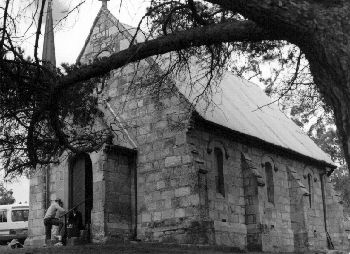 Yvonne McBurney's Road to Byng provides a wonderful description:
This beautiful little romantic sandstone structure with a red-tipped spire, steep roof and fretwork eaves, is now frequently used for weddings. The church stands alone on a hill silhouetted by huge evergreens planted many years ago by the proud settlers, who would have walked with their families along the misty hawthorne-lined lanes to the sound of the church bell pealing throught the valley reminding the settlers and copper miners that the day of rest should not be forgotten. At the height of its development 600 people lived in the village of Byng.
Yvonne McBurney's Road to Byng provides a wonderful description:
This beautiful little romantic sandstone structure with a red-tipped spire, steep roof and fretwork eaves, is now frequently used for weddings. The church stands alone on a hill silhouetted by huge evergreens planted many years ago by the proud settlers, who would have walked with their families along the misty hawthorne-lined lanes to the sound of the church bell pealing throught the valley reminding the settlers and copper miners that the day of rest should not be forgotten. At the height of its development 600 people lived in the village of Byng.
A Cultural Significance Study and Architectural Survey was undertaken on behalf of the Byng Church Trust and the Cornish Association of New South Wales by Rodney Climo in 1986 in preparation for a submission to the New South Wales Council of the Australian Bicentennial Authority. Apart from seeking a substantial grant for the repair and upkeep of the Chapel as a building of heritage significance, Climo hoped that, as a result of the Study, there would be action from all concerned for the conservation of the building, its site area, and the graveyard.
The Study revealed many interesting aspects of the design and construction of the Chapel, showing the care which had been taken in the choice of materials and offering comments on the significance of the choices made. The chapel stone is an acid volcanic rock known as tuff, produced by the consolidation of volcanic ash and other volcanic fragments found around volcanic openings. It is porous and is not subject to salt attack like sandstone. Tuff is a reasonably common local stone and, from a distance, resembles yellowblock sandstone in appearance. It is not surprising then that Yvonne McBurney took it to be a sandstone structure, as there are many buildings in Sydney constructed with this fine yellow stone.
CANSW Involvement
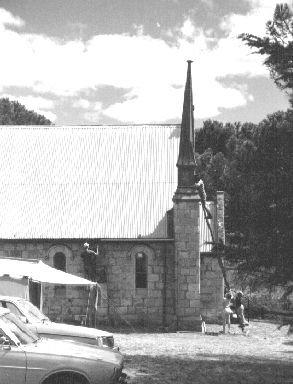 In mid-1976, CANSW Members met with Raymond Hawke, a descendant of George Hawke, to discuss a proposal that a group would go to Byng to tidy the Chapel and its cemetery. The first operations were undertaken by members in October 1976. Since that time, there have been regular visits to Byng to clear undergrowth from the cemetery, to cut the grass and to start on repairs to the Chapel. In 1981, new gutters were fitted to the Chapel and steps were taken to interest the National Trust in Byng.
In mid-1976, CANSW Members met with Raymond Hawke, a descendant of George Hawke, to discuss a proposal that a group would go to Byng to tidy the Chapel and its cemetery. The first operations were undertaken by members in October 1976. Since that time, there have been regular visits to Byng to clear undergrowth from the cemetery, to cut the grass and to start on repairs to the Chapel. In 1981, new gutters were fitted to the Chapel and steps were taken to interest the National Trust in Byng.
By 1983, it was noted that five weddings had been held at the Chapel and all present had passed laudatory comments on the improvements to the appearance and general repair of the Chapel. A CANSW member was appointed as a Trustee of the Byng Chapel in that same year. There had been increased interest being shown by local people.
After the CANSW Secretary, Chris Dunkerley, had arranged for Government architect, Rodney Climo, to look at the Chapel to determine what might be done for Bicentenary grant improvements, maintenance on a number of aspects were begun in 1986. Work was started on window repairs, internal walls had cracks filled and then all painted. TAFE students erected scaffolding to repair and make a new spire. Everything was done to finish by January 1988, the beginning of the Bicentennial Year. A great deal of work was carried out by local residents, some working through five consecutive weekends, to ensure that restoration was completed on time for the re-dedication ceremony.
In January 1988, the restored Byng Chapel was full and overflowing for the re-dedication ceremony. A special plaque was unveiled by Ruth Cocks, then CANSW President, commemorating the CANSW input to the restoration. A splendid vellum, created by member Geoff Ford and now in the Chapel, lists the names of Association members who were heavily involved in the maintenance and restoration. The upkeep work continues each year. The Chapel has become a special place for baptisms and weddings of young people whose ancestors lived and worked at Byng. They come from far and wide, north NSW and Queensland, for such ceremonies; they and their families are delighted that this has been made possible.
Byng during the Orange 150th Year Celebrations
On Sunday, 27 October 1996 at 3 pm, a special commemorative service was held at Bethel Rock after the opening of the Heritage Trail in Orange at 1.30 pm. The Hawke family had prepared a track cut through the grass up to within 100 metres of the Rock where the service was held. The Orange Town Crier with his bell called the people to the service, the bell resounding up the valley even as must have happened in the days of William "Parson" Tom. You can see and read about the service in the Menu listed Orange Page. After the service, in true Cornish style, tea was served at the Rock site.
The Chapel itself had been used for a wedding on the Saturday with all the attendees arriving by bus. It was said to be a joyous occasion. It was looking a fine place in the sunshine with the green grass and the very old trees all around.
But Why is Cornish Settlement now Byng?
As Philip Payton put it in his book The Cornish Miner In Australia: "... together the colonists decided upon the name of Cornish Settlement for their village (alas, it was later changed to the boring and unimaginative Byng)."
Higher authority (Governor Fitzroy) in 1854 approved that the village reserve be known as the Parish of Byng, Bathurst County, soon after the gold discovery at Ophir. The village boundaries of Byng were established in the Government Gazette on 5 December 1881 and by 19 April 1893, the village was proclaimed as Byng Goldfields. This is a separate page (Menu Item - Gold from Ophir)about the find of Australia's first payable gold and the involvement of William Tom Jnr, James Tom and John H.A. Lister.
In their wisdom, higher authority had used the name of Admiral John Byng who had been sent to relieve the British garrison at Fort St Philip in Minorca, under siege by the French fleet. It was considered that he failed in his mission and was court-martialled on his return to England, for disobeying orders to defeat the French. There was a strong public outcry when the verdict was announced but, despite it, he was shot at Portsmouth in 1757. The Admiral became a popular hero as a result. You can read more details in the Encyclopaedia Britannica if you want more details.
Perhaps one can agree with Philip Payton's sentiments but not necessarily his two descriptive adjectives! It is easy to understand why some prefer to use the title Cornish Settlement, with all its associated history. And that history is still recognised by the Orange Family History Group and the Orange District Historical Society, members of which met with member of the Cornish Association of NSW in Orange on September 6-7, 1997. It was a gathering worth remembering, with some of the story of the meeting displayed in another page on the Orange District Historical Museum and the Tribute to the Tom family.
Further alterations to this page were made on 10 October 1998 by the CANSW Webmaster, Dr John L. Symonds.

 In the early days of the Settlement after 1829, these Cornish pioneers understood that walls alone do not make a meeting place, just as John Wesley had demonstrated in their home county. Their initial chosen place of worship was the top of a ridge, soon known as Bethel Rock, and this served as 'Parson' Tom's pulpit. In the photograph, Bethel Rock is the exposed rock close to the downslope to the right.
In the early days of the Settlement after 1829, these Cornish pioneers understood that walls alone do not make a meeting place, just as John Wesley had demonstrated in their home county. Their initial chosen place of worship was the top of a ridge, soon known as Bethel Rock, and this served as 'Parson' Tom's pulpit. In the photograph, Bethel Rock is the exposed rock close to the downslope to the right. Yvonne McBurney's Road to Byng provides a wonderful description:
This beautiful little romantic sandstone structure with a red-tipped spire, steep roof and fretwork eaves, is now frequently used for weddings. The church stands alone on a hill silhouetted by huge evergreens planted many years ago by the proud settlers, who would have walked with their families along the misty hawthorne-lined lanes to the sound of the church bell pealing throught the valley reminding the settlers and copper miners that the day of rest should not be forgotten. At the height of its development 600 people lived in the village of Byng.
Yvonne McBurney's Road to Byng provides a wonderful description:
This beautiful little romantic sandstone structure with a red-tipped spire, steep roof and fretwork eaves, is now frequently used for weddings. The church stands alone on a hill silhouetted by huge evergreens planted many years ago by the proud settlers, who would have walked with their families along the misty hawthorne-lined lanes to the sound of the church bell pealing throught the valley reminding the settlers and copper miners that the day of rest should not be forgotten. At the height of its development 600 people lived in the village of Byng.
 In mid-1976, CANSW Members met with Raymond Hawke, a descendant of George Hawke, to discuss a proposal that a group would go to Byng to tidy the Chapel and its cemetery. The first operations were undertaken by members in October 1976. Since that time, there have been regular visits to Byng to clear undergrowth from the cemetery, to cut the grass and to start on repairs to the Chapel. In 1981, new gutters were fitted to the Chapel and steps were taken to interest the National Trust in Byng.
In mid-1976, CANSW Members met with Raymond Hawke, a descendant of George Hawke, to discuss a proposal that a group would go to Byng to tidy the Chapel and its cemetery. The first operations were undertaken by members in October 1976. Since that time, there have been regular visits to Byng to clear undergrowth from the cemetery, to cut the grass and to start on repairs to the Chapel. In 1981, new gutters were fitted to the Chapel and steps were taken to interest the National Trust in Byng.
